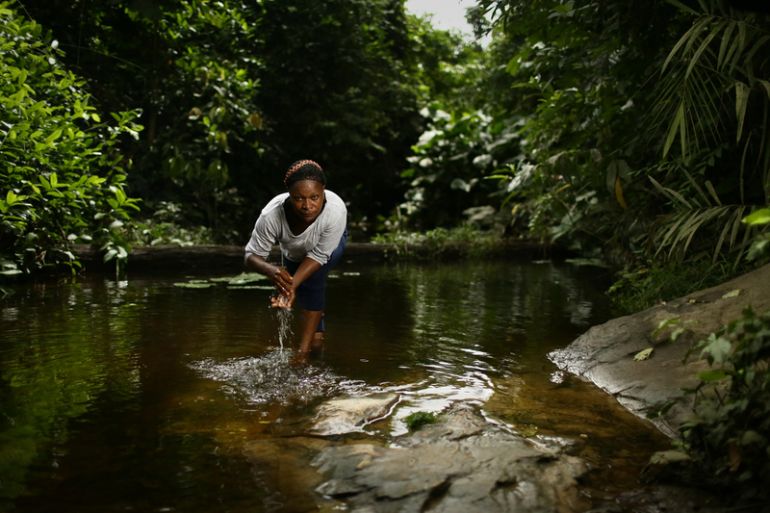To protect nature, bring down the walls of fortress conservation
New global protection targets must shift power from polluting industries to Indigenous people and local communities.

The crisis signs could not be clearer: fires, floods, droughts, pandemic, species extinction … Earth is screaming with all its might. We need to listen and act.
We must defend the planet’s life support against relentless corporate greed and rediscover humanity as part of the natural world, for current and future generations. Restoring balance requires governments to heed the knowledge of communities who have listened deeply and worked with Mother Nature for generations – and to recognise and respect the rights of Indigenous peoples and local communities.
Keep reading
list of 4 itemsAfter the Hurricane
World’s coral reefs face global bleaching crisis
Why is Germany maintaining economic ties with China?
Business-as-usual backed by polluted politics is the problem. The same destructive systems that are stripping our forests and oceans of life are killing environmental defenders and pushing people into peril. To reset our relationship with nature, we need systemic change to the way we produce and consume food, energy and natural resources.
At every level of governance – from our local community to the UN biodiversity summit – decisions can aid a green and just recovery from crises, build resilience against future epidemics, and allow people and the planet to thrive. As governments collectively agree on next steps for global nature protection, it is clear we need a better plan.
Protecting at least 30 percent of land and oceans by 2030 can be an important component in planetary recovery. It is an ambitious, measurable target. A global safety net preventing further degradation of critical eco-regions is essential and could halve the extinction risk for species. But only if failed conservation models are discarded in favour of a global push to recognise customary land and reinforce people’s rights – this is key if countries are to protect biodiversity, fight inequality and attain their climate goals.
While many of the most effective and highly protected ocean sanctuaries have been championed and won by local coastal communities, the 30×30 target for land has been met with deep concern from environmental and human rights groups and activists: Designed without proper consultation and implemented wrongly, protected areas do not deliver protection but make matters worse for people, endangered species, and the planet. The current draft post-2020 Global Biodiversity Framework (GBF) lacks credible guarantees against such an outcome. Success depends on approaches that both promote justice and protect biodiversity and the GBF must reflect that.
We have seen how people power can effectively push back on greedy companies. In Mexico’s Cabo Pulmo, local communities secured legal protection and are reviving marine life and livelihoods. With legal rights and instruments to enforce them, Indigenous people have defended their territories from encroachment, invasion and exploitation. Studies from Brazil show that this is the most effective way to safeguard forest and biodiversity in the Amazon. There is a lot of potential in providing people with the means to resist industrial expansion that is contributing to species loss, climate breakdown and deepening inequalities. For example, tedious bureaucratic processes must be simplified in Indonesia and Indigenous people fighting for community forestry management in the Democratic Republic of the Congo must be sufficiently supported as part of new and more ambitious global protection targets.
However, there is a much darker side of conservation that commits human rights violations and outright atrocities in its name. This needs a reckoning as governments set higher targets for protected areas.
So-called “fortress conservation” – which evicts people from land that has been home to Indigenous peoples and local communities for generations – is ethically deeply problematic and has had horrific consequences on the ground. In the Congo Basin and elsewhere, armed eco-guards funded by international donors and organisations have reportedly harassed, abused, raped and murdered local people. These atrocities are not standalone incidents, they are the outcome of a failed conservation model predicated on colonialism that treats marginalised and forest-dependent communities as a threat to wildlife.
This outdated conservation approach must be discarded entirely. It is not a solution to the planetary crisis we are faced with and needs ruling out before governments look for “easy ways” to meet 30×30 targets. This needs to happen fast or there is a very real risk we see a boom in colonial-style conservation that pushes millions of people off their land.
A worst-case outcome of land protection targets would be a rush of offset or greenwashing projects that allow states and corporations with large ecological footprint and greenhouse gas emissions to retain their unsustainable business model by investing in top-down managed protected areas. This would further exacerbate social injustice, infringe rights, and undermine dignity and avenues for prosperity for local and Indigenous communities who are guardians of biodiversity.
We will not live in “harmony with nature”, as the Convention on Biological Diversity vision states, if we throw people off their land and make it inaccessible for customary use. We cannot remedy the immense destruction from industrialised capitalist exploitation of nature by placing the burden of repairing on those least responsible.
To turn the tide on nature destruction, decision-makers must listen to, support and respect those who have lived close and long with healthy ecosystems. Governments must ensure local and Indigenous rights to land, and leadership in planning and managing protected areas. And provide robust legal instruments to defend these rights.
Global biodiversity decisions affect us all. Those shaping them must recognise the interconnected crises of climate, biodiversity and global inequality and promote a shift of power that enables the guardians of biodiversity to help protect us all.
The views expressed in this article are the authors’ own and do not necessarily reflect Al Jazeera’s editorial stance.